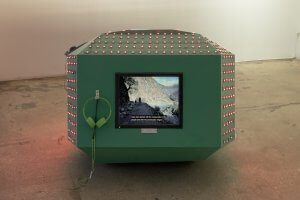Energies | New York Times
Oct 03 2024

By Zoë Hopkins and Travis Diehl
What to See in N.Y.C. Galleries in October
This week in Newly Reviewed, Zoë Hopkins covers Álvaro Urbano’s recent ruins, Lubaina Himid’s roguish drama and a group show that grapples with the climate crisis.
EAST VILLAGE
Energies
This exhibition’s story begins in 1973, when a group of tenants in the East Village installed a two-kilowatt wind turbine on the roof of their building. It was reportedly the first urban windmill in the United States, and one of its blades now hangs on a wall at the Swiss Institute, blocks away from the turbine’s original site.
“Energies” takes on the vast problem of energy waste and consumption through the prism of this local grass-roots experiment. Archival documents about these intrepid tenants and their building, 519 East 11th Street, are on view alongside contemporary art that probes the history and present reality of this crisis around the world.
The Peruvian artist Ximena Garrido-Lecca’s video installation “Yacimentos” (2013) lingers on the environmental devastation wrought by mining for renewable energy materials, while Saba Khan’s sculpture “Indus Water Machine (Number 3)” (2020) evokes the architecture of midcentury hydropower dams in Pakistan.
Some of the artworks create their own renewable energy: An installation on the roof by Haroon Mirza includes solar panels that activate his sound installation; Agnieszka Kurant’s installation, “Living Currency” (2014), is powered by energy generated when visitors open a gallery door.
The exhibition also happens outside of the Swiss Institute, like a kind of sprawling energy circuit. In the courtyard at 519 East 11th Street, the Nigerian artist Otobong Nkanga has painted a mural that pictures a sort of network of relations connecting people, architecture, trees and factories, suggesting the flow and transfer of energy among a variety of beings. At St. Mark’s Church in-the-Bowery, a once-forgotten installation by Gordon Matta Clark — consisting of a single rose bush — has been revivified, blooming red anew.
Though the scale of the climate crisis is inconceivably large, “Energies” suggests what is possible when we direct our imaginations toward our immediate orbit.
